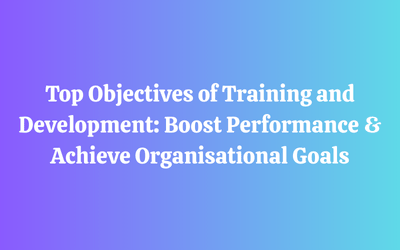How to Measure Training Effectiveness
Your company hopes to benefit from training and development by gaining better knowledge and productivity, higher retention rates, and a stronger brand. You must follow up on any corporate training you provided by asking the following questions:
- How successful was the program in assisting students in acquiring useful information and skills?
- Could the students use what they had learned to enhance their performance at work?
- What additional advantages did the training program bring about?
These questions must be answered by measuring the results to decide whether the training was worthwhile for your company’s investment.
What Are Metrics for Training Evaluation?
You want to be sure you are receiving the most value for your money when it comes to training. This is why it’s crucial to monitor your training program’s evaluation measures. Evaluation metrics can provide you with a wealth of information regarding Measure Training Effectiveness of your training and can guide you in making any necessary adjustments. You can track a variety of different evaluation measures, and which ones you choose will depend on the particulars of your training plan. Some frequent evaluation measures are participant satisfaction, learning outcomes, behavior changes, and performance improvements.
Why Are Corporate Training Metrics Important?
Measure Training Effectiveness are crucial because they enable organizations to gauge the success of their training initiatives. Businesses may identify areas where their training techniques need to be improved and ensure that their employees are getting the most out of their education by tracking data such as employee happiness, knowledge retention, and skill progress. Finally, ensuring that staff members are adequately taught and prepared for their roles, aids firms in achieving their business goals.
How to Measure Training Effectiveness
You need to be able to gauge the success of your training, just like you would with anything else in life, to know if it is helping you achieve your objectives. To do this, you can employ several evaluation metrics. Learner outcomes and process measures are the two broad categories that these metrics fall under.
Your training is intended to produce learner outcomes, such as improved customer service or higher levels of productivity. Process measurements track things like how much they learned and how engaged they were in the session. There are a lot of various assessment measures you may use to measure student outcomes, such as test scores, course completion rates, job satisfaction, and task performance.
The number of training hours completed, the level of trainer satisfaction, and participant engagement are some examples of process measures. The evaluation criteria you choose will depend on the sort of training you’re providing and your specific training objectives. However, it’s important to use a mix of both types of metrics to get a well-rounded view of your training’s effectiveness.
When Should I Utilize a Training Assessment for Employees?
Knowing when and how to evaluate employee training is crucial. You can’t tell whether your staff members are understanding the topic and upholding the standards of your business without conducting the proper assessment. Fortunately, you can assess the success of staff training using a variety of evaluation indicators. One frequent metric is post-training job performance. This gauges how well workers execute their brand-new duties the following instructions.
Scores from tests or other types of assessment are another popular statistic. You can determine how well employees understood the topic by looking over the quiz results. Training can be used to gauge employee happiness as well. Surveys and interviews are two options for doing this. Employee satisfaction reveals whether or not your staff members think they are getting the most out of their training and whether they think it is assisting them in reaching your objectives.
Finally, you can quantify how much training has benefited employee performance. This can be done by comparing pre-and post-training data. The most effective training modalities can be identified by examining improvement rates.
Why Assess the Efficacy of Training?
Data show that businesses all around the world make significant investments in staff development. Research estimates in 2020, the United States will have spent 42.4 billion on employee education and training. Measuring training efficacy is a crucial technique for increasing employee engagement and retention in addition to improving knowledge and skills. When preparing for the next workshops, results and data from previous training can serve as crucial indicators.
Companies should make sure that workers can show how training has increased their productivity and general skill development. With the growing focus on continual learning and development, businesses are keen on identifying reliable metrics and methods to measure the training effectiveness and the ROI of such employee training initiatives. After all, you would not want to give training that does not provide the intended results.
Analyzing the Efficacy of Training
The success of training can be evaluated by post-training tests, one-on-one conversations, employee surveys, participant case studies, and formal certification exams, among other methods. Your company’s return on investment will be easier to calculate the more data you gather on quantifiable results. It is helpful to make a plan for the variables you will be monitoring and the methods you will use to get the data before training even starts. Fortunately, there are already several tested methods for determining how successful training is.
Level 1- Reaction.
This level evaluates the training’s relevance and usefulness as well as how the students respond to it. To get feedback from students on their learning experience, use surveys, questionnaires, or conversations with them before and after the course.
The following subjects should be discussed:
- Was the course material understandable and pertinent?
- Inquire about the lessons learned and important conclusions.
- Discuss the program’s advantages and disadvantages.
- Determine whether the training was able to take the learner’s pace and learning type into account.
After Level 1, you ought to be able to assess how effectively the training was received and identify any content shortages.
Level 2 – Learning
As a result of the training, evaluate the knowledge and skills that the students have acquired. You can combine many metrics, such as the following, to gauge this level:
- Test results before and after training Assessment of projects including applied learning
- Having an impact on performance KPIs
- Completion and certification of the course
- feedback from the supervisor
At this point in the review process, you will be able to ascertain whether the training is accomplishing its intended goals, what specific skills may be acquired through this training, and the potential for content and delivery method enhancements.
Level 3 – Conduct
Recognize the effects of the training on the learner’s behavior and attitude at work. Using a mix of these techniques, assess how the training has impacted the learner’s performance and delivery at work:
- questionnaires for self-evaluation
- feedback is given informally by peers and supervisors
- Focus sessions
- Job-related observation
- Key performance indicators for actual job performance (KPIs)
- customer feedback forms, remarks, or grievances
What should be covered in your evaluation includes:
- How has education been applied in the workplace?
- Are the students comfortable imparting their new knowledge and abilities to their peers?
Level 4 – Results
Assess the training’s observable effects, such as cost savings, quality enhancements, quicker project completion, enhanced productivity, staff retention, better marketing leads, higher sales, and improved morale. Important metrics to monitor are:
- better business outcomes
- Higher output and job quality Retention of employees
- greater morale
- Index of consumer satisfaction
How Much Measurement Is Practical?
The Kirkpatrick model can be expensive and time-consuming to implement at all levels. Everything doesn’t have to be measured. Measure only what is necessary to make an informed choice about the training’s return on investment.
Leslie Allan suggests adding levels as follows, according to the type of training and your goals:
Level 1 (Reaction) for all programs
Level 2 (Learning) for “hard-skills” programs
Level 3 Behavioral for strategic programs
Level 4 (Results) for initiatives that cost more than $50,000
Conclusion
Training is all about enhancing both individual and group performance, which in turn affects how well your business performs overall. It’s critical to assess the training’s effectiveness and confirm that the initial learning objectives were met.
I am also aware that training has numerous intangible benefits. Even though they may seem intangible, elements like job satisfaction, learning enjoyment, and fostering an understanding among staff members that they are valuable assets deserving of development can have a significant impact.
Lastly, unless you use what you have learned to enhance the training, locate a better provider, or even decide to end the program, measuring training is useless. It’s important to define and support continuous learning pathways so that your employees can continue to be relevant in a digital environment that is constantly changing. Training cannot, however, be a one-time event.
Learn More
Our News
- AI
- Animations
- Articulate
- Articulate 360
- Articulate Engage
- Articulate Live
- Articulate Presenter
- Articulate Quizmaker
- Articulate Replay
- Articulate Review
- Articulate Storyline
- Articulate Storyline 3
- Articulate Studio
- bite sized learning
- Characters
- Content Library
- Corporate Communication
- E-Learning
- e-Learning Authoring Tools
- Employee Engagement
- Game-Based Learning
- Gamification
- Gamiflexer
- Go Sales
- Healthcare
- Instructional Design
- Interactivity
- Knowledge Transfer
- L&D Trends
- Learning
- Learning & Development
- Learning Experience platform
- Learning Management System
- LMS
- LXP
- Microlearning
- mLearning
- Mobile Learning
- Nugget Learning
- Online Training
- Peek
- Performance Support
- Preso
- Quiz and Assessment Platform
- Replay 360
- Rise
- SCORM
- Screen Capture
- Software
- Storyline 360
- Studio 360
- Training Management
- Trainings
- Uncategorized




